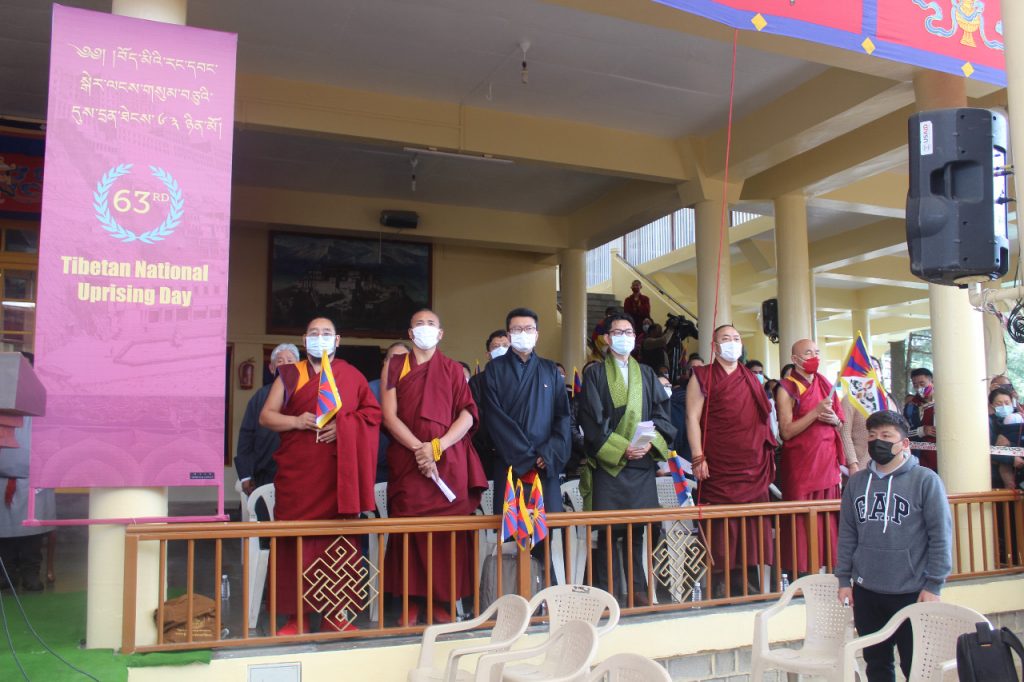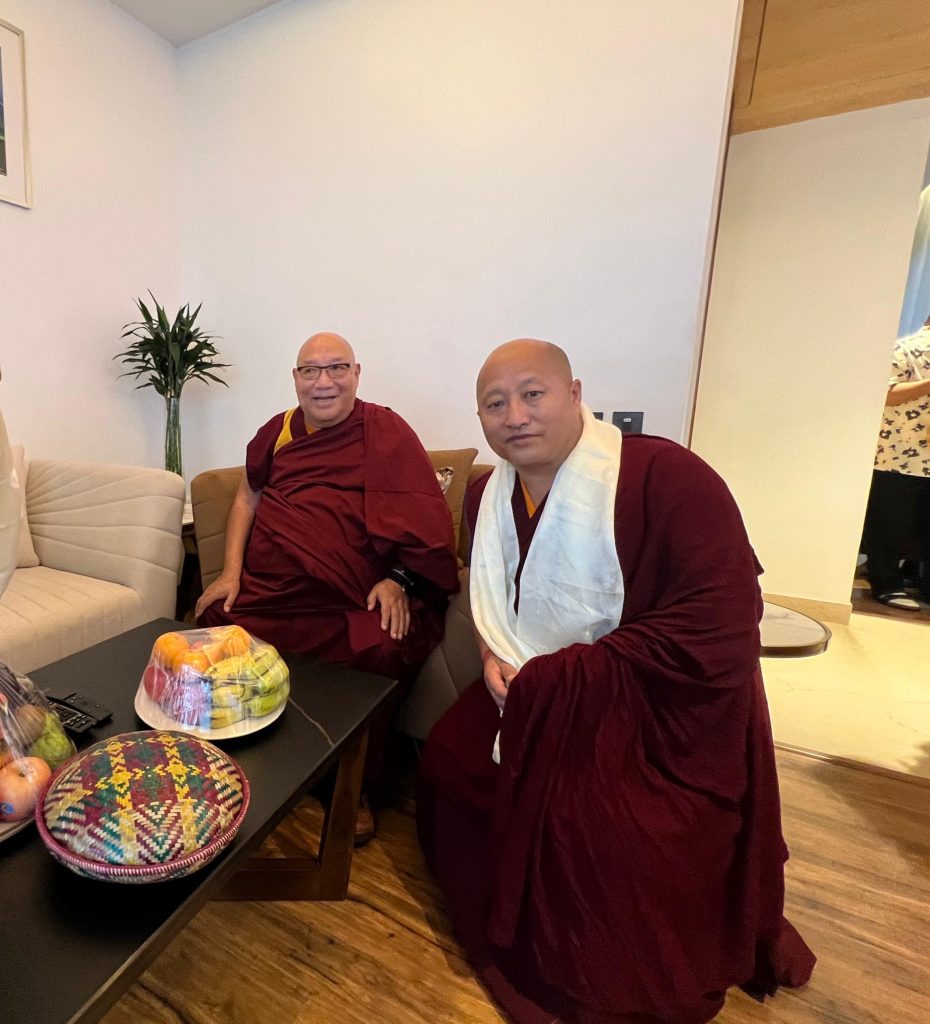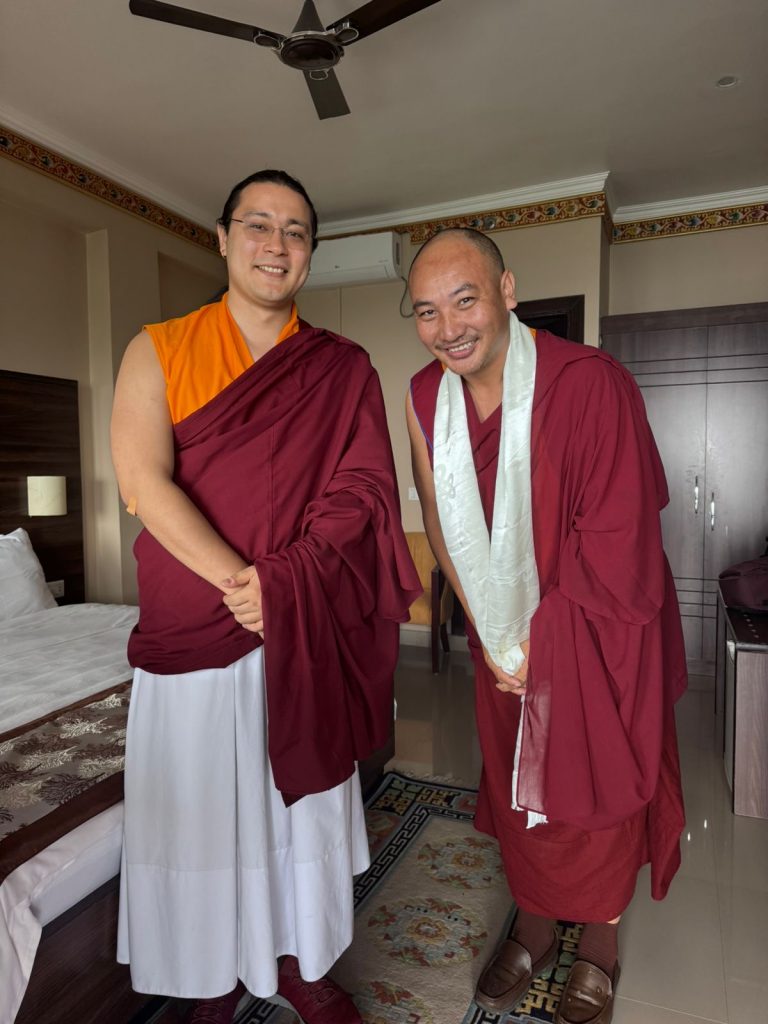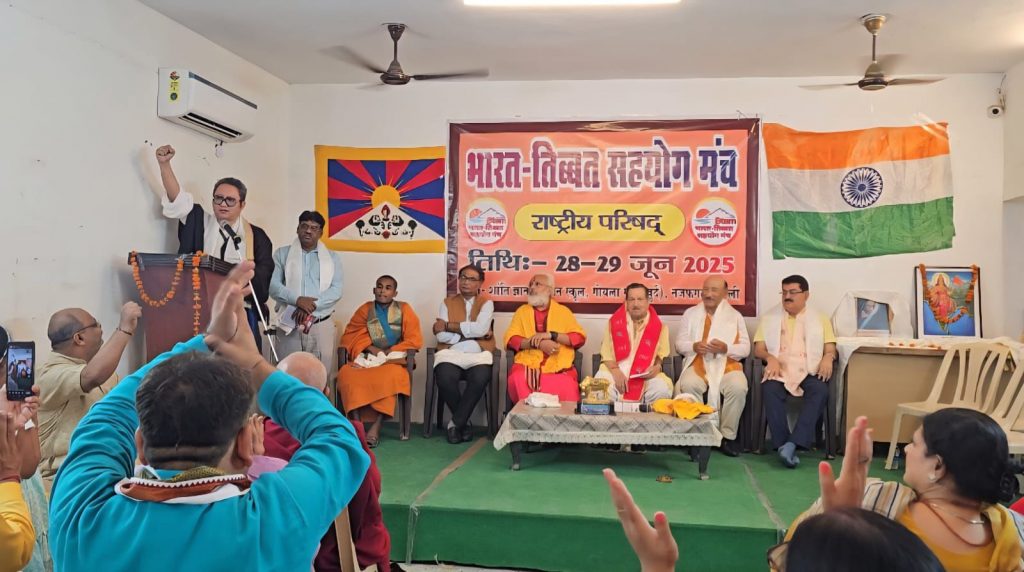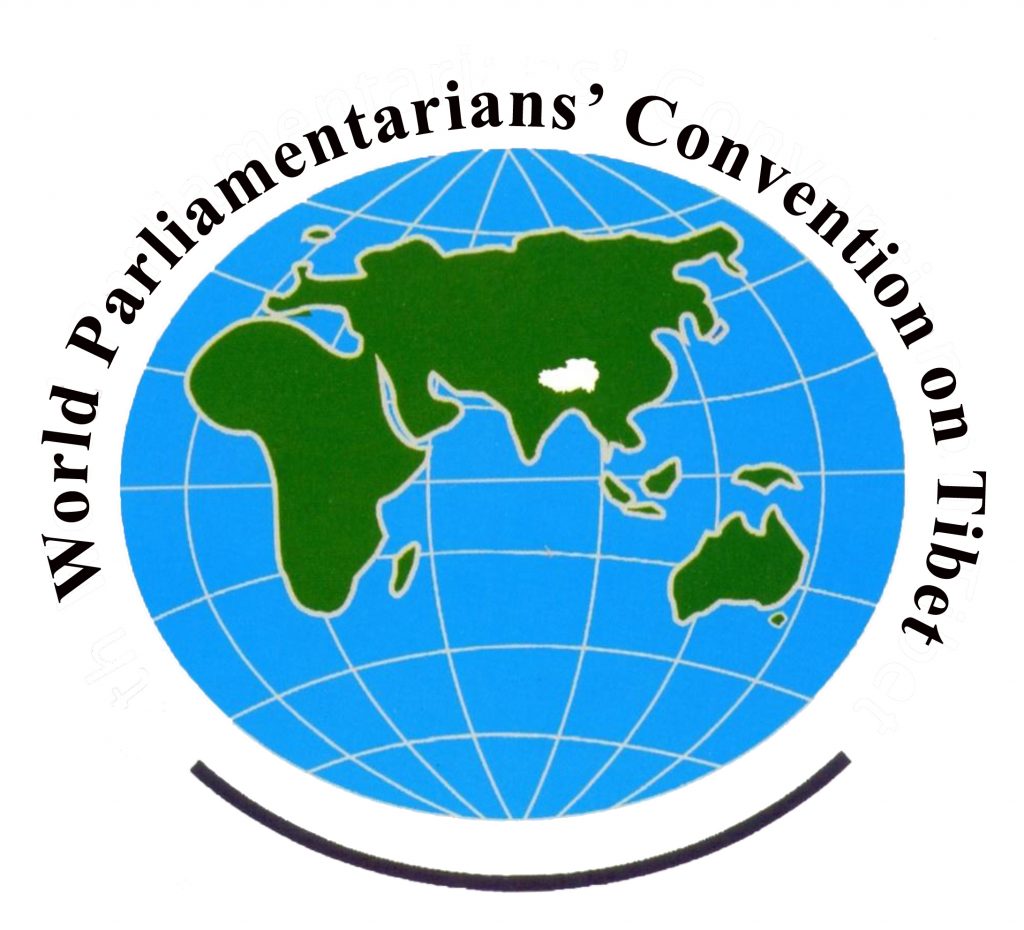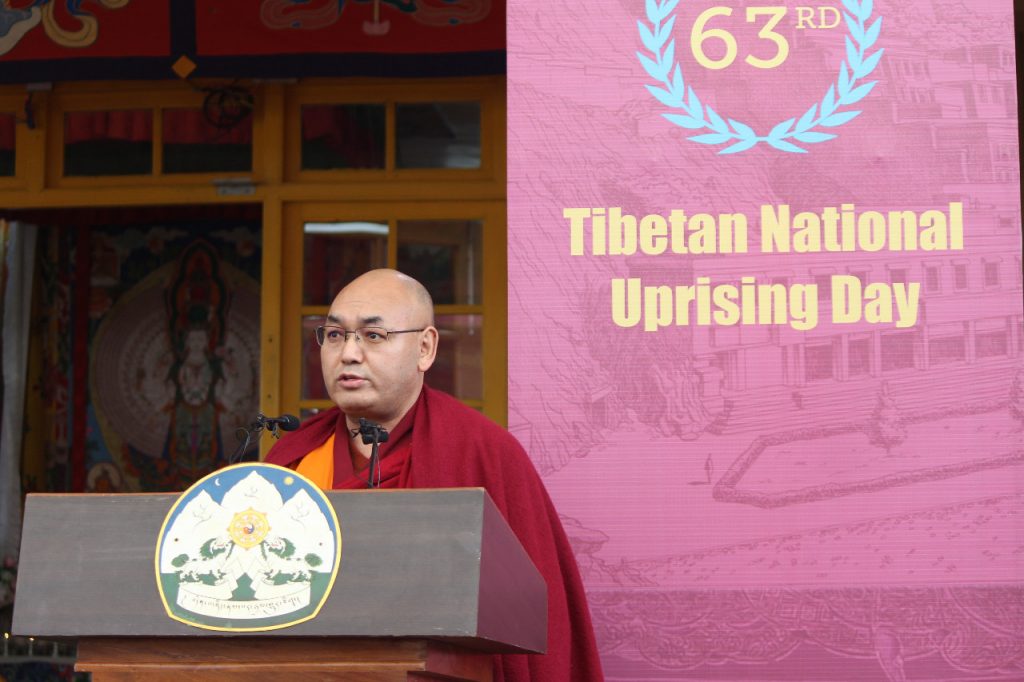 Today we commemorate the 63rd anniversary of an event which took place in Lhasa, the capital of Tibet, in 1959, when the Tibetan people staged a peaceful uprising against the armed invasion and occupation of their homeland and the grossly inhuman brutality the occupying communist Chinese enemy employed to persecute the Tibetan people. More than ten thousand people belonging to all the three provinces of the nation, made up of both the lay public and the monastic communities, rose in a spontaneously collective surge of a peaceful uprising in that historic event. Today is also our Martyr’s Day. And so, on this occasion, the Tibetan Parliament in Exile wishes to offer its obeisance as well as prayers with heartfelt remembrance for the patriotic men and women of Tibet who with courage and determination have thus far sacrificed their all, including their invaluable life, for the greater good of the common Tibetan cause. At the same time, the Tibetan Parliament in Exile also wishes to offer its empathy and solidarity with the Tibetan people in Tibet who to this day continue to suffer persecution under the oppressive rule of the government of China.
Today we commemorate the 63rd anniversary of an event which took place in Lhasa, the capital of Tibet, in 1959, when the Tibetan people staged a peaceful uprising against the armed invasion and occupation of their homeland and the grossly inhuman brutality the occupying communist Chinese enemy employed to persecute the Tibetan people. More than ten thousand people belonging to all the three provinces of the nation, made up of both the lay public and the monastic communities, rose in a spontaneously collective surge of a peaceful uprising in that historic event. Today is also our Martyr’s Day. And so, on this occasion, the Tibetan Parliament in Exile wishes to offer its obeisance as well as prayers with heartfelt remembrance for the patriotic men and women of Tibet who with courage and determination have thus far sacrificed their all, including their invaluable life, for the greater good of the common Tibetan cause. At the same time, the Tibetan Parliament in Exile also wishes to offer its empathy and solidarity with the Tibetan people in Tibet who to this day continue to suffer persecution under the oppressive rule of the government of China.
In this connection, it bears recalling that immediately after a new so-called people’s government of China was established with the founding of the People’s Republic of China in 1949, preparations were started for an armed invasion of Tibet. Proclaiming its move as what was claimed to be a peaceful liberation of Tibet, China carried out an armed invasion and occupation of its neighbouring country in an all-out violation of each and every provision of international law and conventions. Such then was the oppressiveness of the circumstance in which Tibet was compelled, under duress, to sign a so-called “17-Article Agreement on Measures for the Peaceful Liberation of Tibet” in the year 1951. Even then, China, the occupying power, gradually reneged on each and every provision of this so-called 17-point agreement as it kept on becoming ever more repressive. And it implemented in Tibet numerous coercive policy measures such as Democratic Reform which were grossly at odd, and in no way in keeping, with the ground reality in Tibet. The underlying agenda of these policy measures included the marginalization of or otherwise trampling on the religious and cultural heritage of the Tibetan people without showing any sense of regard for them. Under their implementations, countless numbers of Tibetan people were executed or otherwise persecuted in various ways. But that was not all. The occupying power even hatched a plot that fell nothing short of targeting the personal safety of His Holiness the Dalai Lama. This was what left the general masses of the Tibetan people with no other option but to launch a widespread protest campaign on the 10th of March in 1959. It was from the occasion of this spontaneously aroused uprising of the general masses that the Tibetan people, on their own, kept commemorating this day as the Tibetan Uprising Day. And they have to this day carried out a variety of peaceful protest campaigns on all sorts of occasions under different circumstances against the communist Chinese government for its brutally oppressive policy measures which were aimed at obliterating the Tibetan identity, including the very ethnicity of the Tibetan people.
Over the past more than six decades, the government of communist China has, under such brutally repressive policy campaigns as the so-called “quelling the rebellion”, “Democratic Reform”, “Class Struggle”, “People’s Commune” system, “Cultural Revolution” movement, and “Military Control Committee” system of governance, executed or otherwise directly caused the untimely death of well over one million people of Tibet thus far. Including with the destruction without a trace many thousands of places of worship and religious study of the Tibetan people, the occupying power’s pogrom of destruction, plunder, and takeover of Tibet, encompassing both the Tibetan territory and its inhabitants, was horrifying beyond imagination. In addition, the government of China has been relentless in its continued pursuit of a design to obliterate the very ethnic identity of the Tibetan people, along with their religion, culture, language and everything else. In this way the government of China deprived the Tibetan people, the rightful owners of their national territory, of everything they ever owned, including the most basic of their human freedoms while subjecting them to such degrees of persecution and torture as if they stood condemned to live in hell on this land of the living itself. There is no mistake about the fact that the ultimate objective of the government of China is to turn Tibet into Chinese both in its outer form and internal substance. Such then is the seriousness of the extremely distressing situation in Tibet today.
The policies of cruelty the government of China has kept on implementing in Tibet and those that it is carrying out even today have never been acceptable to the Tibetan people. They compelled the Tibetan people to carry out peaceful campaigns to rebel against them one after another in a relentless chain of protest actions. One culmination of this was reached in the year 2008 when starting from Lhasa, Tibetans in all the three historical provinces of their country carried out nationwide campaign of protest actions. The government of China responded to these peaceful demonstrations with utmost cruelty, with its armed forces using weapons of war and live-ammunition on the protesters, unrestrained by the presence of a feeling of even a tiniest bit of mercy while cracking down on the Tibetan people. It led to hundreds of Tibetans, both laypeople and monastics, being killed, while thousands of other people were rendered disappeared. Many more were arrested, jailed or persecuted in other ways. In particular, it bears noting that since the year 2009, starting with monk Tabey, until the 25th of February this year in an incident involving the popular Tibetan singer Tsewang Norbu-la on the square in front of the Potala Palace, a total of 156 Tibetan people have carried out protests accompanied by acts of setting themselves on fire, shouting calls and slogans that included raising the demand that His Holiness the Dalai Lama be invited back to Tibet and that the human rights of the Tibetan people be respected. These Tibetan people thereby carried out in an unprecedented manner a new form of protest campaign against the government of China. But, sadly, the leadership of the communist Chinese government did not even consider trying to solve the issue of Tibet in a positive way. Rather, it persisted on misrepresenting the actual situation in Tibet with nothing but outright lies and distorted narratives, thereby concealing the reality as much from its own people as from the concerned people in the international community by means of employing all sorts of propaganda subterfuge.
Xi Jinping, the current President of China, has embarked on a new propaganda drive to promote the communist ideology and in a bid to control or restrict the way the people of his country think. In order to prevent the occurrence of any obstacle to the centralised authoritarian power of the communist party leadership under him, the monitoring and controlling of internet access of the people has been greatly strengthened. Considerable investment surpassing previous allocations has been directed at the development of ever newer high-level technological gadgets that were designed to strengthen the effectiveness of all-round control on the people of China’s freedom of access to and use of the internet. The move has also been designed to ensure a stricter control on people’s freedom of speech. Besides, the fact that China is pursuing a policy of imposing a ban on carrying out religious activities over the internet is a subject being currently reported about. By means of employing the latest, high-level internet technology of various kinds, the government of China has multiplied the degree of control it exerts on the people belonging especially to the ethnic minority groups, including the Tibetan people, in terms of their psychology and on all aspects of their behaviour – their movement, their stay, and their activities. Subjected to such tightly planned and supervised control measures by the Chinese government, the whole society is being turned into a dystopian one devoid of any meaningful basic freedom.
Policies of so-called ideological education and a two-language formula in education are being implemented in Tibet by the government of China. Under it, hundreds of thousands of Tibetan students are taken away to China, deprived of any opportunity to maintain contact with their families, taught all their subjects in their schools only in Chinese language with a view to Sinicize them in their personal character and behaviour. In order to strengthen the achievement of this design, the government of China has implemented measures to shut down privately run Tibetan schools. This is accompanied by the Tibetan students being especially made to study the policies of the Communist Chinese government and speeches of its leaders. By such means, the government of China has embarked on a sinister plot to render the Tibetan people devoid of anyone who had inherited their ancestrally rich language and culture. Likewise, the government of China is presently also seen to be implementing in Tibet a recruitment policy under which people with qualification in Tibetan language find it almost impossible to get a job in the government or its institutions.
The government of China claims that it respects the religious freedom of the Tibetan people. However, the reality is the opposite. It has newly established in the monasteries in Tibet such bodies as the Monastery Management Committee, with its role being to supervise the religious functioning of these places of religious study and practice. In the year 2007, the government of China announced a set of regulations known as Documents No. 5. Under it, the government of China took full control over the recognition of reincarnations of lamas and tulkus in Tibetan Buddhism. Later in a so-called White Paper released in 2015, the government of China said that it had accorded approval to a total of 358 reincarnations of Tibetan Buddhist leaders. This is a gross violation of the unique Tibetan Buddhist tradition and procedure for the discovery, recognition, and enthronement of reincarnations of such religious figures. Likewise, the government of China has banned any Tibetan who is yet to reach the age of 18 from being enrolled as a monk or nun. Monasteries are required to put on conspicuous display in their prayer assembly halls portraits of top leaders of China. Various types of campaign actions aimed at Sinicizing the Tibetan tradition of Buddhism are actively being carried out. Through these and other similar types of actions, the government of China is continuing to exercise control and impose restrictions on the Tibetan people’s practice of their religious freedom. There is therefore no denying the fact that the government of China is in gross and systematic violation of the rights of the Tibetan people with regard to the exercise their religious freedom.
In December 2021, the government of China began to carry out a series of religious and related destructions in Draggo County in the traditional Tibetan province of Kham. They included a 99-feet statue of the Buddha built at the Gaden Rabgyal Namgyal Ling Monastery, an imposing statue of the Maitreya Buddha, prayer wheels each containing a hundred million rounds of the text of the six-syllable Tibetan Buddhist mantra for the invocation of the Avalokiteshvara bodhisattva, and a monastic school. And then again, just recently, the government of China demolished at the Chanang Monastery belonging to the Nyingma tradition of Tibetan Buddhism, also located in Draggo County, a three-storey high statue of the Padmasambhava Buddhist master. During the destruction carried out at the Draggo Monastery, abbot Paga and many other Tibetan people were arrested or kept under detention in other ways. By such actions, the government of China not only severely curtailed the religious freedom of many Tibetan people but also implemented in Tibet what amounted to a revival of the brutalities of the Cultural Revolution movement in China.
On the 26h of October in 2020, China’s public security personnel arrested and took away in Chengdu City eminent Tibetan writer Go Sherab Gyatso. And for more than one year, there was no information on the whereabouts of this scholar monk. Later in February 2021, a Chinese court in Tibet’s capital Lhasa tried and sentenced him for having allegedly engaged in separatist activity to a jail term of 10 years. His health condition remains precarious today as he already had a lung ailment at the time of his arrest and this has been worsened by poor conditions in jail as well as due to the beatings he was subjected to in prison. Likewise, there has been no word whatsoever from the government of China on the whereabouts and the condition of the 11th Panchen Lama Gedhun Choekyi Nyima Rinpoche ever since it kidnapped this totally innocent person more than 25 years ago. Along with them, the government of China should release as soon as possible all Tibetans it has imprisoned thus far for political reasons. Including the United Nations Organization, The Tibetan Parliament in Exile also calls upon human rights organizations, governmental bodies and non-governmental organizations across the world to take serious interest in the situation of political prisoners, the human rights situation, and the state of religious freedom of the people in Tibet, East Turkestan, and Inner Mongolia as they continue to suffer persecution under the repressive rule of the government of China by raising questions and holding discussions with its leadership. The purpose should be to make efforts to encourage the government of China to relax and liberalize its hardline policy on them.
The plateau territory of Tibet was a fully independent country from any characteristic point of view – its history, territoriality, ethnicity, culture, linguistic heritage, customs and traditions, and so forth. Nevertheless, it has been under the rule of an expansionist China for over seventy years now. However, the world is dynamic and many changes have been keeping on taking place across it all the time. Eventually, this trend of continuing change is bound to reach Tibet too. This is the basis on which we take the opportunity provided by this occasion to again reiterate our call on the leadership of the government of China to enter into a substantive dialogue on the basis of the mutually beneficial Middle Way Policy which is in keeping with the desire of His Holiness the Dalai Lama and which has also been adopted by the Tibetan parliament in Exile.
The just struggle of the people of Tibet has continued to draw support – as it still does – from the international community, including governments, parliaments, non-governmental organizations, and private individuals. Apart from that, overseas Chinese intellectuals and democracy activists, as well as many unbiased Chinese intellectuals within the People’s Republic of China itself have continued to offer support to our cause with words of empathy and praise. Likewise, the government of the United States of America has adopted legislative policy documents in support of the issue of Tibet. Also, the issue of Tibet has continued to be a topic of discussions in such parliaments as of countries in Europe, as well as of Japan and India. These developments show that the issue of Tibet is continuing to become an ever more relevant and important one internationally. This is a cause for delight and pride to the Tibetan people. It is therefore befitting that the Tibetan Parliament in Exile is emphatic in appealing to fellow-Tibetans to be clearheaded in being able to discern what is right and what is wrong on any issue of concern and be clear in their stand accordingly. This is the basis on which they should contribute to the common cause whatever capability they may have, keeping in mind the urgency to maintain the unity of the Tibetan people and the aim to achieve the basic aspiration of the Tibetan people, as is exactly the wish of His Holiness the Dalai Lama too.
It has been the practice thus far that after they had assumed their office, the first undertaking of the members of the Tibetan Parliament in Exile should be to tour the various Tibetan settlements and in clusters of communities elsewhere and to meet with the Tibetan people living in them. The 17th Tibetan Parliament members successfully toured most of the places. Likewise, a five members delegation of the Standing Committee of the Tibetan Parliament-in-Exile undertook a Tibet Advocacy programme in New Delhi. And the visit was a great success and culminated in the revival of the All-Party Indian Parliamentary Forum for Tibet. Programmes are presently being worked out for the members of the Tibetan Parliament in Exile to undertake in the near future international visits, including to the parliaments of various countries, to lobby for more support and for the purpose of expanding the base of our global ties in this endeavour. The Tibetan Parliament in Exile expects as well as requests cooperation from all concerned to ensure the success of these planned efforts.
Over the past more than ten days, the people of Ukraine have been put through a great deal of misery. And their suffering today is somewhat similar to what the people of Tibet had been put through some seventy years ago when People’s Republic of China invaded Tibet and unleashed a campaign of violent repression under its occupation rule. It is therefore pertinent that the Tibetan Parliament in Exile conveys to the innocent people of Ukraine its feeling of common cause and expression of solidarity with them. And we pray that the people of Ukraine may be freed from their current spell of hardship and misery as soon as possible.
Yet another matter that certainly deserves mentioning on this occasion for the Tibetan Parliament in Exile is to offer its gratitude to the governments, especially of the United States of America, the parliaments, and the non-governmental organizations across the world, but particularly to the government and people of India, for their continued help and support for the issue of Tibet.
And finally, the Tibetan Parliament in Exile fervently offers prayers that His Holiness the Dalai Lama, the common treasure of the Tibetan people, may live for a hundred aeons, that on this basis all his wishes may be seen fulfilled with utmost spontaneity, and that the just cause of the Tibetan people may be seen achieved with absolute certainty, culminating in the sunshine of happiness dawning in Tibet, with the Tibetan people in Tibet and in exile being reunited.
The Tibetan Parliament in Exile
10 March 2022
. . . . . . . . . . . . . . . . . . . . . . . . . . . . . . . . . . . . . . . . . . . . . . . . . . . . . . . . . . . . . . . . . . . . . . . . . . . . . . . . . . . . . . . . . . . . . . . . . . . . . . . . . . . . . . . . . . . . . . . . . . . . . . . . . . . . . . . .
* In case of any discrepancy between this English translation and its Tibetan original, the latter should be considered as authoritative and final for all purposes.
